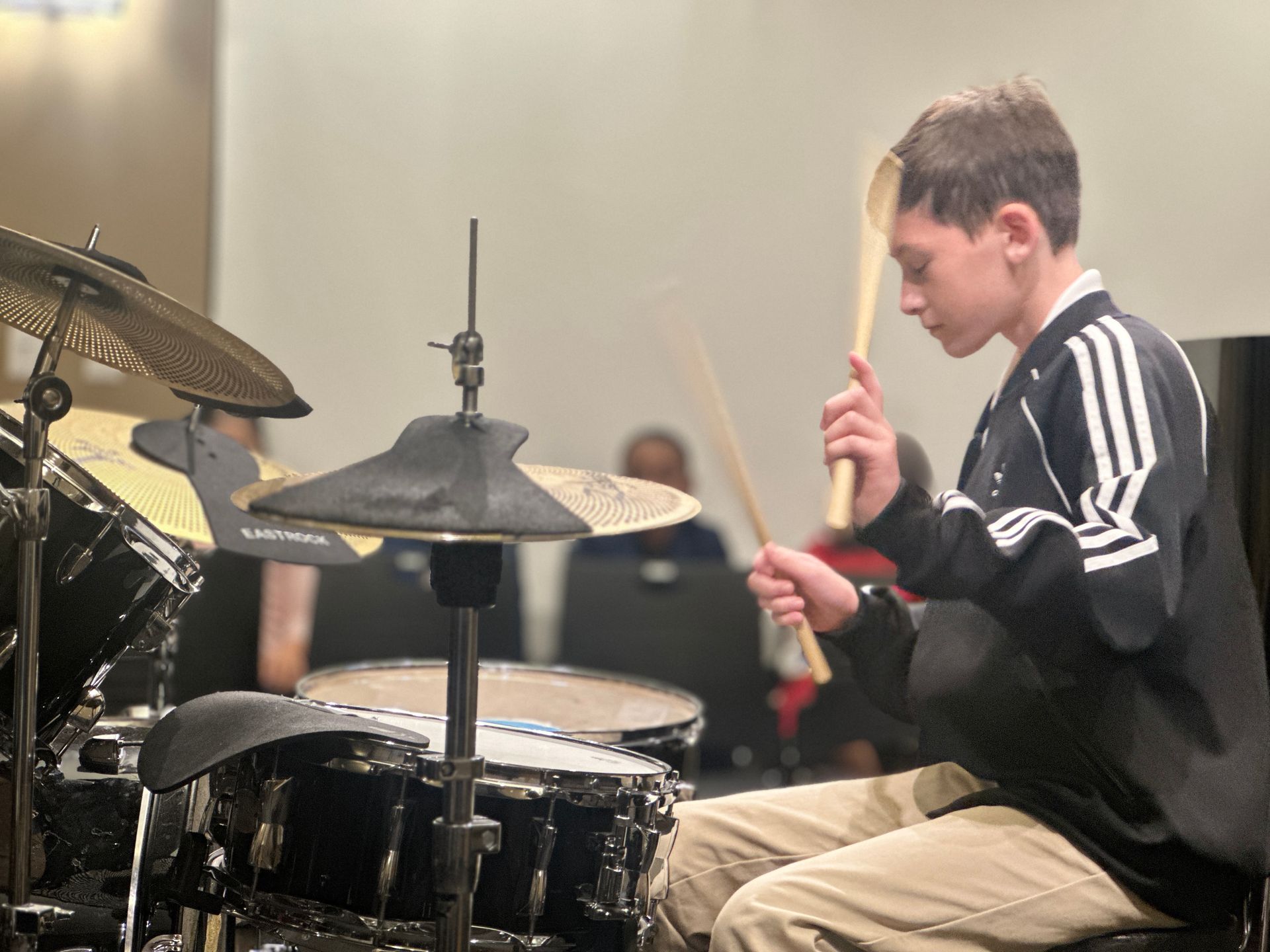
How to Play Drums for Beginners: Find Your Rhythm & Master the Basics
Have you ever caught yourself tapping along to a song, wondering what it would feel like to create those beats yourself? Learning to play the drums is more than just keeping time—it’s about feeling the rhythm, expressing creativity, and building a strong musical foundation that can shape your entire approach to music.
Whether you’re a total beginner or someone who has dabbled in drumming but never committed, this guide will walk you through the essential steps to get started. From understanding rhythm to playing your first beat, we’ll break it all down in a way that’s simple, engaging, and easy to follow.
Ready to unlock your rhythm? Let’s dive in.
Why Learning to Play Drums is Life-Changing
Before we get into the techniques, let’s talk about why drumming is such a powerful skill to learn. Beyond just playing music, drumming has a profound impact on your brain, body, and creativity.
Drumming Boosts Brain Power
Did you know that drumming engages both sides of your brain at once? Studies show that playing drums can:
- Improve memory and focus
- Enhance problem-solving skills
- Strengthen coordination and motor skills
Drummers are often great multitaskers because they learn to independently control their hands and feet while maintaining rhythm. This kind of brain workout carries over into other areas of life—whether it's academics, work, or even everyday tasks.
Stress Relief & Emotional Expression
Ever felt the urge to bang on something when you’re frustrated? Drumming provides a healthy outlet for stress. The physical movement, combined with the rhythmic patterns, can be incredibly therapeutic. In fact, research suggests that drumming can:
- Lower stress and anxiety
- Increase dopamine levels (the “feel-good” hormone)
- Promote relaxation and mindfulness
Drumming isn’t just about playing music—it’s about connecting with yourself emotionally and creatively.
The Joy of Musical Creativity
Playing the drums isn’t just about keeping time—it’s about creating grooves, shaping a song’s energy, and developing your own unique sound. As you learn, you’ll discover how to experiment with different styles, from rock to jazz to funk, and find what truly excites you.
Step 1: Understanding Rhythm – The Foundation of Drumming
At the heart of drumming is rhythm. If music were a language, rhythm would be its grammar—the structure that holds everything together.
Before you even pick up drumsticks, it’s crucial to understand how rhythm works and develop your sense of timing.
What is Tempo & Why It Matters
Tempo is the speed of a song, measured in beats per minute (BPM). A slow song might have a tempo of 60 BPM, while an upbeat rock track could be 150 BPM or more.
✔ Try this: Listen to your favorite songs and count along with the beat. This will help you develop an instinct for different tempos.
Counting Beats Like a Pro
Music is typically divided into measures, and most beginner drum beats are played in 4/4 time—meaning each measure contains four beats.
To count in 4/4 time, you simply say:
"1, 2, 3, 4… 1, 2, 3, 4…"
✔ Try this: Tap your foot or clap your hands while counting to four. Once this feels natural, you’re already thinking like a drummer!
Step 2: Learning Your First Drum Beat
Now that you understand rhythm, let’s get hands-on. One of the first beats every drummer learns is the basic rock beat—a simple pattern that forms the backbone of countless songs.
Playing a Simple Rock Beat
A drum kit consists of three key components:
- Hi-hat (played with your dominant hand)
- Snare drum (played with your non-dominant hand)
- Bass drum (played with your foot)
Here’s a basic beat pattern to start with:
- Step 1: Tap the hi-hat on every beat (1-2-3-4).
- Step 2: Add the bass drum on beats 1 and 3.
- Step 3: Add the snare drum on beats 2 and 4.
✔ Practice tip: Start slow and gradually speed up as you get comfortable. Play along with a metronome to keep a steady pace.
Step 3: Mastering Drumstick Grip & Control
Your hands are your primary tools as a drummer, and how you hold your drumsticks plays a huge role in your control, speed, and endurance. If you develop bad habits early on, they can slow you down later—so let’s get this right from the start!
🥢 How to Hold Drumsticks Properly
There are two main elements to a good grip:
✔
Balance – You want to hold your sticks in a way that allows them to bounce naturally.
✔
Relaxation – A tight grip causes tension and limits speed.
A good rule of thumb is to hold the stick about ⅓ of the way up, using your thumb and index finger as the pivot point. The remaining fingers wrap around loosely, guiding the stick rather than squeezing it.
🛠 Try this: Hold a drumstick loosely and let it bounce on a practice pad or snare drum. If it doesn’t rebound freely, adjust your grip until it does.
Step 4: The Different Types of Drum Grips
Different styles of drumming require different grips. Let’s explore the most common ones:
Matched Grip (Most Common for Beginners)
- Used in rock, pop, funk, and modern drumming
- Both hands hold the sticks the same way (hence “matched”)
- Great for power and versatility
Best For: Beginners, drum set players, and general-purpose drumming
Traditional Grip (Used in Jazz & Marching Drumming)
- One hand holds the stick underhand while the other holds it overhand
- Originally developed for marching drummers who played with a tilted snare
- Allows for subtle dynamics but takes practice to master
Best For: Jazz, marching bands, or drummers looking for a unique playing style
German Grip (Power & Volume)
- Palms face downward
- Provides maximum power for loud drumming
- Often used in rock, heavy metal, and orchestral settings
Best For: Power hitters who need loud, aggressive drumming
French Grip (Speed & Precision)
- Thumbs face upward (like shaking hands)
- Focuses on finger control rather than wrist movement
- Great for speed and intricate playing
Best For: Jazz, fast drumming, and detailed stick work
American Grip (Balanced & Versatile)
- A hybrid between German and French grip
- Hands are at a slight angle, offering both power and finesse
- Works well for many musical styles
Best For: Drummers who want a versatile, all-purpose grip
Try this: Experiment with different grips on a practice pad and see which one feels the most comfortable for you.
Step 5: Expanding Your Playing – Basic Drum Rudiments
Now that you have control over your sticks, it’s time to build technical skill with drum rudiments. Think of rudiments as the scales of drumming—they’re short, repeating patterns that help you develop speed, coordination, and musicality.
The 3 Rudiments Every Beginner Should Learn
1. Single Stroke Roll (R L R L)
- The most basic and essential rudiment
- Played by alternating hands in an even, controlled motion
Try this: Start slow, making sure each stroke is even. Gradually speed up while staying controlled.
2. Double Stroke Roll (R R L L)
- Instead of alternating hands, each hand plays two strokes in a row
- Builds wrist strength and control
Try this: Keep your strokes light and bouncy rather than forcing them.
3. Paradiddle (R L R R – L R L L)
- A mix of single and double strokes
- Used in drum fills and more advanced drumming
Try this: Play this pattern slowly, making sure the doubles feel smooth.
Practice Tip: Use a metronome to keep a steady beat. Start at 60 BPM and gradually increase speed as you improve.
Step 6: Getting to Know Your Drum Kit
At this point, you’ve developed control, rhythm, and stick technique. Now, let’s break down the different parts of a drum set so you understand how everything works together.
The Essential Parts of a Drum Kit
- Snare Drum – The centerpiece of your kit, used for crisp, punchy backbeats.
- Bass Drum – Played with a foot pedal, providing low-end power.
- Hi-Hat – Two cymbals controlled with a foot pedal, used for timekeeping.
- Tom-Toms – Add variety to drum fills and different tonal textures.
- Cymbals – Includes crash cymbals (for accents), ride cymbals (for steady grooves), and hi-hats.
Try this: Sit behind a drum kit and get comfortable with each component. Play a simple beat using just the hi-hat, snare, and bass drum to start.
Step 7: How to Read Drum Sheet Music & Tabs
Many beginner drummers assume you don’t need to read music—but learning basic drum notation will give you a huge advantage. It helps you:
- Learn new beats and songs faster
- Communicate better with other musicians
- Understand and create your own drum parts
Understanding Drum Notation
Drum sheet music looks different from regular music notation because it doesn’t include melody—only rhythmic patterns. Instead of notes representing pitch, each part of the drum kit has its own position on the staff:
- Bass Drum → Bottom line
- Snare Drum → Middle space
- Hi-Hat → Top space (with an “x” notehead)
- Toms & Cymbals → Different lines/spaces
Example of a basic rock beat in notation:
- Hi-hat (x) on every beat (1-2-3-4)
- Snare (●) on beats 2 and 4
- Bass drum (●) on beats 1 and 3
Try this: Look up a simple drum tab or sheet music for a song you love. Follow along by tapping on your knees or a practice pad.
Step 8: Playing Your First Full Song
Now, it’s time to put everything together and play a full drum beat in the context of a song!
One of the most common beginner drum patterns is called the "Money Beat"—a simple groove found in thousands of songs.
The "Money Beat" (Most Common Drum Groove)
This beat is used in hits like Billie Jean (Michael Jackson), We Will Rock You (Queen), and Seven Nation Army (The White Stripes).
Pattern:
- Hi-hat – Play on every beat (1-2-3-4)
- Bass drum – Play on beats 1 and 3
- Snare drum – Play on beats 2 and 4
Try this: Play the "Money Beat" along with a metronome or a slow song. Start at 60 BPM and gradually speed up as you get comfortable.
Step 9: Setting Up a Practice Routine That Works
To truly improve as a drummer, you need consistent practice. Even 15-30 minutes a day can lead to massive progress over time.
Beginner Practice Routine (45 Minutes Total)
- Warm-Up (10 min) – Play single strokes, double strokes, and paradiddles on a practice pad.
- Drum Rudiments (10 min) – Pick one rudiment (like a single-stroke roll) and gradually increase your speed.
- Basic Beats (10 min) – Practice the "Money Beat" and experiment with small variations.
- Play Along with Music (10 min) – Choose an easy song and try to match the beat.
- Freestyle & Creativity (5 min) – Have fun! Experiment with your own fills and grooves.
Pro Tip: Use a metronome to keep your timing solid. Increase the BPM slightly each week to challenge yourself.
Final Thoughts – Your Drumming Journey Starts Now!
Congratulations! You now have:
- A strong foundation in rhythm and drumming technique
- The ability to read basic drum music and tabs
- A solid practice routine to improve daily
Drumming is a lifelong journey, and the best part is—it only gets more fun from here! As you keep practicing, you’ll develop your own style, gain confidence, and maybe even start playing in a band.
Ready to take the next step?
Sign up for drum lessons today! https://www.musicinstitutent.com/student-registration-form
Request Info here!
https://www.musicinstitutent.com/contact
